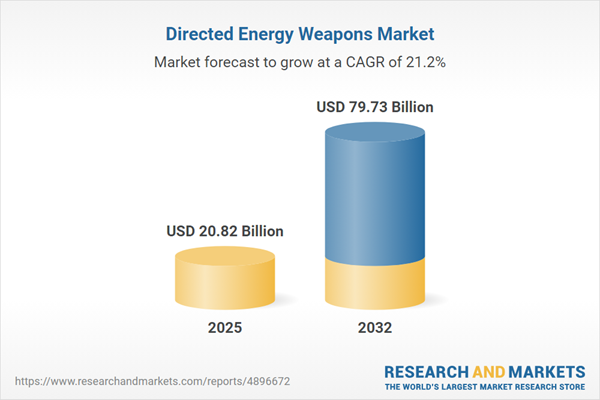Speak directly to the analyst to clarify any post sales queries you may have.
Directed energy weapons are shaping the future of defense technology, opening new pathways for senior decision-makers to realize operational efficiency and modernize organizational capabilities. As global attention intensifies, understanding the full landscape is crucial for timely, strategic investments in this swiftly advancing sector.
Market Snapshot: Directed Energy Weapons Market Overview
The global directed energy weapons market is positioned for significant expansion, with a current valuation of USD 17.11 billion in 2024. Market forecasts project growth to USD 20.82 billion by 2025 and USD 79.73 billion by 2032, corresponding to a 21.20% compound annual growth rate. This rapid trajectory is propelled by advancements in photonics, improved energy storage, and innovative material engineering. Broader adoption across military platforms and a shift toward revised procurement strategies are accelerating modernization efforts. Evolving compatibility requirements and dynamic deployment patterns highlight the need for agile investment approaches and adaptable risk strategies within the directed energy weapons sector.
Scope & Segmentation of the Directed Energy Weapons Market
This report clarifies how critical market segments and emerging technologies intersect, equipping leadership with actionable intelligence for capital allocation:
- Type: Chemical lasers, fiber lasers, solid-state lasers, active denial systems, high-power microwaves, electron beams, and proton beams; each category serves mission-specific defense and security requirements or supports disruptive technology deployments.
- Application: Defense, homeland security, industrial, and research environments; use cases span force protection, area denial, technology innovation, and experimental evaluation.
- Platform: Land, airborne, maritime, and space-integrated systems; these enable rapid response, long-duration missions, and integrated operations across various theaters.
- Power Output: High-power solutions enhance long-range operations for extensive missions, while low-power options emphasize flexibility and precision in both mobile and static scenarios.
- Region: North America, Latin America, Europe, Asia-Pacific, Middle East & Africa; each exhibits unique procurement cycles, regulatory frameworks, and evolving investment priorities that influence adoption.
- Key Companies: Lockheed Martin, Raytheon Technologies, Northrop Grumman, Boeing, BAE Systems, Thales, Leonardo, L3Harris Technologies, General Atomics, Rheinmetall; these industry leaders maintain momentum through collaboration and development of specialized solutions.
Emerging use cases involving miniaturization and integrated beam control allow organizations to diversify operational scenarios, supporting multi-platform deployments and maximizing capability across regions with variable resource constraints.
Key Takeaways for Senior Decision-Makers
- Adopt flexible risk management frameworks to address volatility in the defense technology market and ensure organizational compliance with evolving global standards.
- Build strategic alliances across technology sectors to encourage innovation, enable rapid deployment cycles, and ease integration of advanced capabilities into existing systems.
- Focus investments on modular, scalable architectures, ensuring that acquisition remains aligned with evolving operational and mission requirements over time.
- Strengthen procurement and supply chain processes to streamline the integration and mobility of directed energy systems, maintaining responsiveness to emerging security threats.
- Promote ongoing research in miniaturization and advanced beam management, aligning these advancements with the need for mobility, targeting accuracy, and adaptability across platforms.
Tariff Impact and Supply Chain Adaptations
Recent updates to US tariff regulations affecting critical components have prompted organizations to diversify their supplier bases and embrace global sourcing. Senior leaders are increasingly forming international research partnerships to enhance project resilience, reduce deployment disruptions, and support continuity amid regulatory fluctuations. This adaptability not only mitigates logistical challenges but also ensures that defense operations remain efficient and responsive in changing policy environments.
Methodology & Data Sources
All findings in this report are drawn from expert interviews, comprehensive reviews of authoritative secondary literature, and rigorous internal verification. Insights are triangulated from multiple credible sources to deliver reliable, executive-ready guidance for investment planning and operational decision-making.
Why This Directed Energy Weapons Market Report Matters
- Empowers senior executives to advance capital planning and streamline the integration of directed energy systems with evolving defense strategies.
- Supports proactive procurement measures and supply chain planning to bolster readiness amid unpredictable geopolitical and regulatory shifts.
- Provides focused, actionable analysis that aligns technology uptake with critical organizational and security goals.
Conclusion
This report enables senior leaders to anticipate threats, refine investment priorities, and strengthen organizational readiness as directed energy weapons redefine defense landscapes globally.
Additional Product Information:
- Purchase of this report includes 1 year online access with quarterly updates.
- This report can be updated on request. Please contact our Customer Experience team using the Ask a Question widget on our website.
Table of Contents
3. Executive Summary
4. Market Overview
7. Cumulative Impact of Artificial Intelligence 2025
Companies Mentioned
The companies profiled in this Directed Energy Weapons market report include:- Lockheed Martin Corporation
- Raytheon Technologies Corporation
- Northrop Grumman Corporation
- The Boeing Company
- BAE Systems plc
- Thales S.A.
- Leonardo S.p.A.
- L3Harris Technologies, Inc.
- General Atomics
- Rheinmetall AG
Table Information
| Report Attribute | Details |
|---|---|
| No. of Pages | 195 |
| Published | October 2025 |
| Forecast Period | 2025 - 2032 |
| Estimated Market Value ( USD | $ 20.82 Billion |
| Forecasted Market Value ( USD | $ 79.73 Billion |
| Compound Annual Growth Rate | 21.2% |
| Regions Covered | Global |
| No. of Companies Mentioned | 11 |









